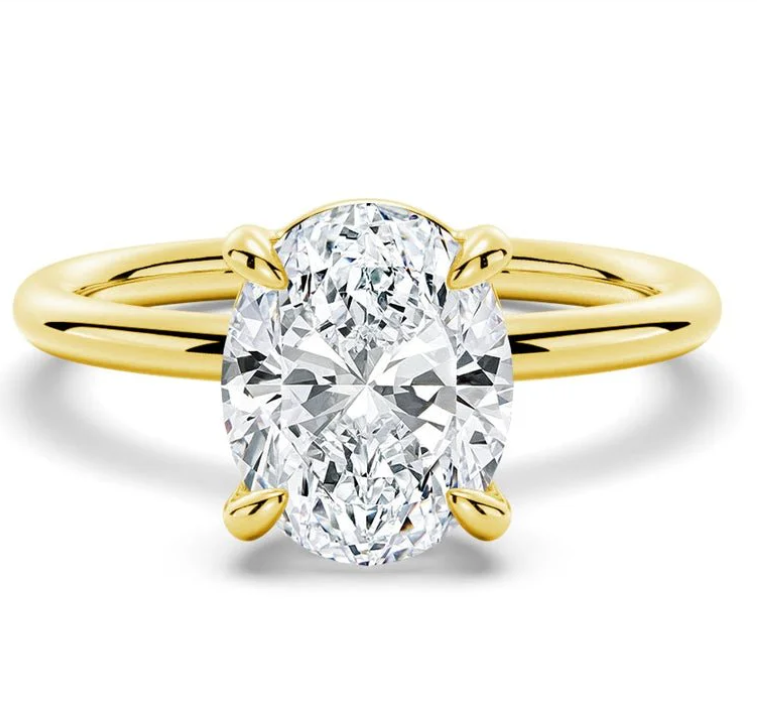Moissanite vs. Diamonds - Is Moissanite the Real Diamond Alternative?
What is Moissanite?
Moissanite is a naturally occurring crystal made of silicon carbide, often regarded as a substitute for diamonds. Though it bears a striking resemblance to diamonds in appearance, moissanite is not a true diamond but rather a diamond simulant. Due to its high similarity to diamonds, Moissanite has become one of the common alternatives to diamonds. In jewelry such as engagement rings, moissanite ranks as one of the most popular choices just after diamonds.
Moissanite was initially discovered by scientist Henri Moissan in 1893 in a meteorite crater, where he mistakenly identified it as diamonds. Natural moissanite is extremely rare, hence most moissanite available in the market is lab-grown. Manufacturing a moissanite can take approximately 2-3 months.
Moissanite is a gemstone of excellent quality, maintaining a bright and beautiful appearance. Unlike other types of diamonds, moissanite does not lose its brilliance or luster over time, as it possesses the best hardness and refractive index among all gemstones in the market.
Moissanite VS Diamonds: What’s the Difference?
While moissanite closely resembles diamonds in appearance, there are several key differences between them. Firstly, moissanite is about 15% lighter than diamonds, so it is typically sold by length and width in millimeters rather than carat weight. Thus, a moissanite equivalent in size to a 1-carat diamond would not actually weigh 1 carat. Additionally, the selling criteria for moissanite differ from diamonds, usually based on size and color (colorless or near-colorless), rather than pricing based on factors like the 4Cs in diamonds.
From a chemical perspective, diamonds consist of pure carbon, whereas moissanite consists of silicon carbide, leading to different physical properties. moissanite exhibits double refraction, meaning it bends light differently from diamonds, and has a slightly lower density than diamonds.
Another significant difference lies in their hardness, typically measured using the Mohs scale. Diamonds are the hardest natural substance on Earth, with a Mohs hardness of 10, making them resistant to scratching or damage. In comparison, moissanite has a Mohs hardness of 9.25, still very sturdy but slightly less durable than diamonds, potentially developing scratches and abrasions over time.
Despite being slightly less hard, moissanite has higher fire and brilliance than diamonds. The refractive index of moissanite ranges from 2.65-2.69, while that of diamonds is 2.42, meaning Moissanite produces more rainbow-like flashes of light. Additionally, moissanite is much cheaper compared to diamonds, priced at around $400 to $600 per carat, whereas a one-carat diamond could range from $2,000 to $20,000.
The Advantages of Moissanite
- Cost: Moissanite can be a more cost-effective option for budget-conscious individuals as it is much cheaper than diamonds.
- Brilliance:Moissanite's refractive index is higher than that of diamonds, making its appearance more vibrant with more fire or sparkle.
- Environmental Impact: Moissanite has a smaller environmental footprint compared to mined diamonds as it is a lab-created gemstone.
The Disadvantages of Moissanite
- Durability:While moissanite is still a durable gemstone, its lower hardness compared to diamonds means it may be more prone to scratches and damage over time, but proper maintenance can ensure longevity.
- Color: Diamonds possess a nearly colorless appearance that some people prefer, whereas moissanite may have a slight yellow or green hue.
The Advantages of Diamonds
- Durability:Diamonds being the hardest natural material in the world, make them extremely sturdy, scratch-resistant, and less prone to damage.
- Rarity:Diamonds are an extremely precious and rare gemstone, which can add to their allure and emotional significance.
- Colorless Appearance:Many prefer diamonds for engagement rings due to their excellent clarity and colorless appearance.
The Disadvantages of Diamonds
- Cost:Diamonds are pricier compared to moissanite, which can be a barrier for individuals on a tight budget.
- Environmental Impact:Carbon emissions and habitat destruction are just two examples of significant environmental impacts of diamond mining.
How to Differ Moissanite from Diamonds?
- One of the simplest ways to distinguish moissanite from diamonds is by observing them under a magnifying glass. Since most moissanite exhibits double refraction, they will appear doubled under magnification. On the other hand, diamonds have single refraction and won't exhibit double refraction.
- Another method to differentiate is by observing the brilliance of each gemstone. While both moissanite and diamonds are highly brilliant, their light reflection patterns are typically different. Since diamonds usually reflect white or gray light, moissanite often displays more colorful light dispersion.
- Using a diamond tester is the only remaining method for differentiation. These testers identify diamonds based on thermal conductivity and can distinguish them from other substances like silicon carbide.
It should be noted that differentiating moissanite from diamonds can be challenging, especially for those unfamiliar with gemstone identification. If you are unsure whether a gemstone is a diamond or moissanite, it's best to have it examined by a qualified gemologist.
Other Affordable Diamond Alternatives
- Colored gemstones such as sapphires, rubies, and emeralds can create unique engagement rings and are priced lower than diamond engagement rings.
- Lab-grown diamonds, chemically, physically, and optically identical to natural diamonds, are another affordable option. They cost 30-50% less than natural diamonds and are becoming increasingly popular in engagement rings.
- Cubic zirconia is another common diamond alternative, looking nearly identical to diamonds but costing only a fraction of their price.
FAQs About Moissanite
Why is Moissanite so cheap?
Moissanite is a synthetic mineral with low production costs and relatively low value. Compared to diamonds, moissanite is very affordable.
Is Moissanite a real gemstone?
Moissanite is a naturally occurring mineral (silicon carbide). This mineral exists in various rocks but is very rare. The moissanite you find in jewelry is always synthetic and manufactured in a laboratory.
Does Moissanite get cloudy?
Moissanite may not necessarily become cloudy or dull over time if properly cared for. This is why it is one of the most popular diamond simulants. If it appears dull or hazy, it likely needs cleaning.
Does Moissanite have resale value?
Moissanite does have some resale value. While moissanite is inexpensive, resale prices for high-quality moissanite are typically around 30-50% of the original price.
Is Moissanite durable?
Moissanite is a very durable gemstone, with a Mohs hardness of 9.25. In comparison, diamonds rate at the highest level of 10.
Can Moissanite be used for engagement rings?
Moissanite has become a popular choice for engagement rings due to its unique brilliance, durability, and affordability. Whether moissanite is suitable for an engagement ring depends on personal preference. However, moissanite is not a diamond. It does not possess the same beauty or market value.
Conclusion
In conclusion, while moissanite and diamonds are both popular choices for engagement rings, there are several key differences between them. Moissanite, as an economical and ethical alternative to diamonds, is increasingly popular. However, weighing the pros and cons of each is essential when making a decision.
Moissanite offers brilliance and durability comparable to diamonds at a fraction of the cost, making it an attractive option for budget-conscious consumers. Additionally, its lab-created nature means it is a more ethical choice for those concerned about environmental and humanitarian issues associated with diamond mining.
However, some may still prefer the prestige and tradition associated with natural diamonds, despite their higher price tag. Ultimately, the choice between moissanite and diamonds depends on individual preferences, priorities, and budget constraints.
By considering factors such as cost, aesthetics, and ethical considerations, couples can make an informed decision that aligns with their values and financial situation, ensuring that their engagement ring symbolizes not only love and commitment but also their personal values and beliefs.
Share





















